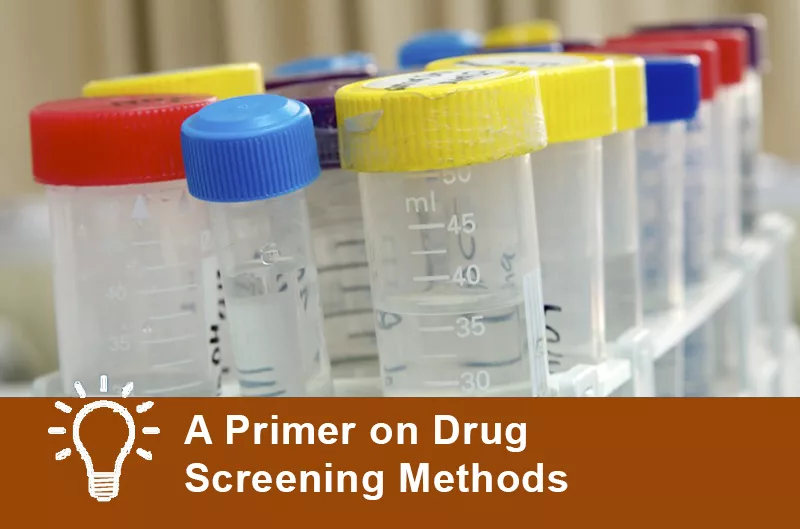Specimens of urine, blood, hair, saliva, sweat and even nails can be used to drug test. Some are more specific, sensitive and accurate than others, says Talia Puzantian, PharmD, BCCP, who goes over the following drug testing methods in The Carlat Addiction Treatment Report:
Urine screening is noninvasive and the most-common type of drug test. It’s available in large volume, and it generally has high concentrations of drugs and metabolites, which allows for longer detection than in blood. Many factors can affect how soon and for how long you can detect a drug, but you can make reasonable predictions. It takes about 2-3 hours for most drugs (only 30 minutes for alcohol) to concentrate in urine, so testing too soon after use in a non-chronic user of a drug may give you a negative result. Most drugs will be detected in urine for about a day or two after use, some longer.
Blood sampling is an accurate way of determining how much of a drug is in a patient’s system, but its detection window is only 6–12 hours. So, unless you can draw the sample in your office, it’s difficult to use for random screens.
Saliva testing includes a swab of the inner cheek and can be used to detect traces of drugs and alcohol. Saliva has an advantage over urine in that it’s harder to adulterate or substitute.
Hair analysis is an easy and non-invasive collection method, and it gives you a much wider detection window (up to 90 days). But it’s not going to be helpful in telling you about your patient’s current substance use (it doesn’t detect use within the previous 7–10 days), and it can’t be used to detect alcohol.
Sweat testing involves a skin patch that looks like a large adhesive bandage, and can be worn by patients for up to 7–14 days. This has become a popular way for parole programs to monitor drug use. It’s non-invasive, easily administered and hard to adulterate (unless the patient removes the patch). This method is limited by availability of testing facilities and it is possible that variability in how much people sweat would affect the results.
Breath testing is the most common way to find out how much alcohol is in someone’s system. Your patient blows into the device and you get a number for the Blood Alcohol Concentration (BAC). It’s only useful for alcohol and has a short window for detection, so it’s not going to be too useful for most clinical settings.
Subscribers can read the entire article, which includes a handy table on the detection periods for urine testing of specific substances. Not a subscriber? Join here.
Urine screening is noninvasive and the most-common type of drug test. It’s available in large volume, and it generally has high concentrations of drugs and metabolites, which allows for longer detection than in blood. Many factors can affect how soon and for how long you can detect a drug, but you can make reasonable predictions. It takes about 2-3 hours for most drugs (only 30 minutes for alcohol) to concentrate in urine, so testing too soon after use in a non-chronic user of a drug may give you a negative result. Most drugs will be detected in urine for about a day or two after use, some longer.
Blood sampling is an accurate way of determining how much of a drug is in a patient’s system, but its detection window is only 6–12 hours. So, unless you can draw the sample in your office, it’s difficult to use for random screens.
Saliva testing includes a swab of the inner cheek and can be used to detect traces of drugs and alcohol. Saliva has an advantage over urine in that it’s harder to adulterate or substitute.
Hair analysis is an easy and non-invasive collection method, and it gives you a much wider detection window (up to 90 days). But it’s not going to be helpful in telling you about your patient’s current substance use (it doesn’t detect use within the previous 7–10 days), and it can’t be used to detect alcohol.
Sweat testing involves a skin patch that looks like a large adhesive bandage, and can be worn by patients for up to 7–14 days. This has become a popular way for parole programs to monitor drug use. It’s non-invasive, easily administered and hard to adulterate (unless the patient removes the patch). This method is limited by availability of testing facilities and it is possible that variability in how much people sweat would affect the results.
Breath testing is the most common way to find out how much alcohol is in someone’s system. Your patient blows into the device and you get a number for the Blood Alcohol Concentration (BAC). It’s only useful for alcohol and has a short window for detection, so it’s not going to be too useful for most clinical settings.
Subscribers can read the entire article, which includes a handy table on the detection periods for urine testing of specific substances. Not a subscriber? Join here.


_-The-Breakthrough-Antipsychotic-That-Could-Change-Everything.webp?t=1729528747)



